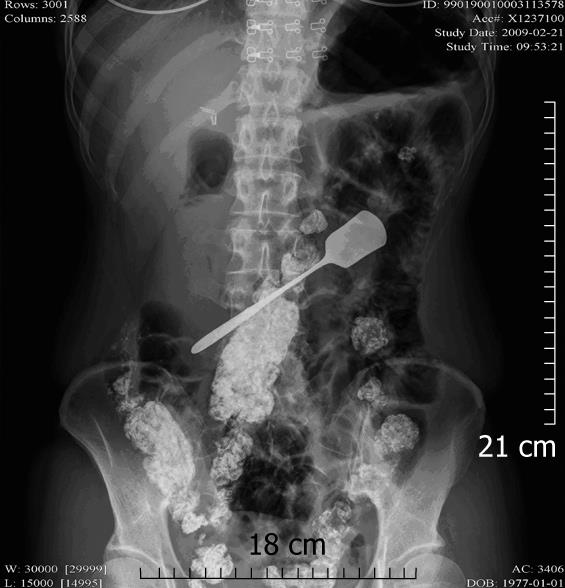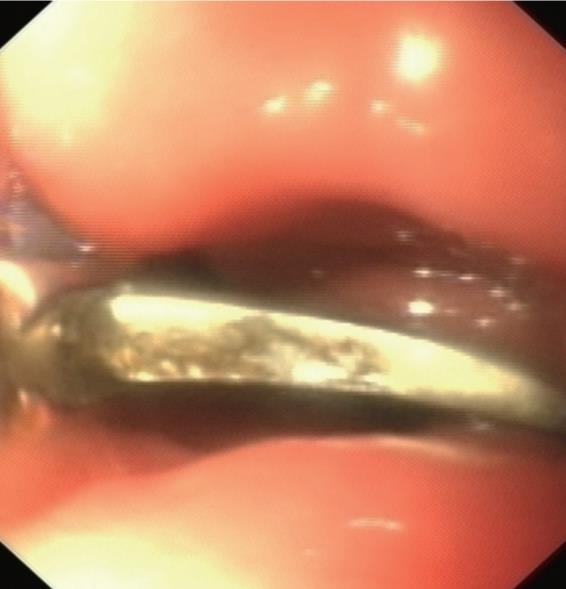Published online Oct 21, 2009. doi: 10.3748/wjg.15.4984
Revised: August 14, 2009
Accepted: August 21, 2009
Published online: October 21, 2009
Foreign-body ingestion is a relatively common presentation at emergency departments, but long metallic spoon swallowing is an infrequent occurrence. Unlike most cases of foreign-body ingestion, there have been no reported cases of long foreign bodies reaching the jejunum. We report a rare case of a coffee spoon that was swallowed accidentally and passed through the pylorus and duodenal loop and reached the jejunum, with no complications.
- Citation: Song Y, Guo H, Wu JY. Travel of a mis-swallowed long spoon to the jejunum. World J Gastroenterol 2009; 15(39): 4984-4985
- URL: https://www.wjgnet.com/1007-9327/full/v15/i39/4984.htm
- DOI: https://dx.doi.org/10.3748/wjg.15.4984
Foreign body ingestion is a frequent gastrointestinal emergency. However, long spoon swallowing is a rare event. Most swallowed spoons have been found in the stomach[1-4]. Previously, there has been no reported case of a long spoon reaching the jejunum. We present a rare case of a swallowed spoon with a length of 15 cm. The object passed through the pylorus and reached the jejunum, without clinical complications.
A 33-year-old woman presented to our emergency room after accidentally swallowing a spoon. She stated that she attempted to use the spoon to remove a fish bone, which was lodge in the pharynx 20 h previously. She had no abdominal pain, fever, vomiting, dysphagia, voice change, cough, or difficulty breathing. The patient was previously healthy and her past medical history was insignificant. General and abdominal examination was unremarkable. There was no abnormal finding in the laboratory tests.
An urgent plain abdominal radiograph revealed a metallic foreign body in the lower mid-abdomen (Figure 1). Inspection and removal was attempted by flexible gastroscopy. Gastroscopy found that a long spoon was resident in the stomach, together with a large volume of food (Figure 2). However, several attempts to remove the spoon failed because the patient could not tolerate the resultant nausea when the spoon was pulled to the cardia. There was a small amount of bleeding around the cardia. To follow-up the migration of the spoon, a second abdominal radiograph showed that the object position had changed (Figure 3). The second endoscopy confirmed that the foreign body disappeared from the stomach. She had to be taken to the operating room for an exploratory laparotomy, which disclosed that a 15-cm spoon had passed into the jejunum, following about 200 cm of the ligament of Treitz (Figure 4). Laparotomy demonstrated no free pus and fluid within the peritoneal cavity. Blood supply for the intestine was good. No bleeding and perforation was found in the stomach and intestine. After surgery, the patient was well and was discharged home on postoperative day 7.
Fortunately, most ingested foreign bodies pass spontaneously from the gastrointestinal tract. However, 10%-20% require nonoperative intervention, and ≤ 1% require surgery[3,5,6]. Foreign bodies may cause serious complications such as impaction, obstruction, or perforation of the digestive or respiratory tracts. When complications occur, there is a relatively high rate of mortality, with death rates as high as 1500 deaths per year in the United States[7].
We tried to remove the spoon by endoscopy. However, our patient could not tolerate the discomfort associated with endoscopy, which had to be discontinued. Surprisingly, the spoon passed through the pylorus and duodenal loop several hours later. We had to remove the foreign body by surgery. In previous studies, long items such as forks or spoons, longer than 6-10 cm, have been unable to pass through the duodenal sweep[5,6]. A Medline search indicated that other swallowed spoons have been found only in the esophagus and stomach. It has not been reported previously that a 15-cm spoon has passed through the pylorus and duodenal loop and reached the jejunum.
Peer reviewer: Norbert Senninger, Professor, Department of General Surgery, University Clinics, Westphalian-Wilhelm’s-University, Waldeyerstrasse 1, D-48149 Muenster, Germany
S- Editor Li LF L- Editor Kerr C E- Editor Yin DH
| 1. | Lin CK, Lee KS, Kuo MC, Lin TJ, Tsai MS. Removal of a mis-swallowed long spoon via gastrotomy--a case report. Kaohsiung J Med Sci. 2002;18:208-210. [Cited in This Article: ] |
| 2. | Beldholm BR, Lee AU. Simple endoscopic technique for retrieving a long foreign body from the stomach. ANZ J Surg. 2007;77:560-561. [Cited in This Article: ] |
| 3. | Aoyagi K, Maeda K, Morita I, Eguchi K, Nishimura H, Sakisaka S. Endoscopic removal of a spoon from the stomach with a double-snare and balloon. Gastrointest Endosc. 2003;57:990-991. [Cited in This Article: ] |
| 4. | Eisen GM, Baron TH, Dominitz JA, Faigel DO, Goldstein JL, Johanson JF, Mallery JS, Raddawi HM, Vargo JJ 2nd, Waring JP. Guideline for the management of ingested foreign bodies. Gastrointest Endosc. 2002;55:802-806. [Cited in This Article: ] |
| 5. | Blaho KE, Merigian KS, Winbery SL, Park LJ, Cockrell M. Foreign body ingestions in the Emergency Department: case reports and review of treatment. J Emerg Med. 1998;16:21-26. [Cited in This Article: ] |
| 6. | Velitchkov NG, Grigorov GI, Losanoff JE, Kjossev KT. Ingested foreign bodies of the gastrointestinal tract: retrospective analysis of 542 cases. World J Surg. 1996;20:1001-1005. [Cited in This Article: ] |
| 7. | Chen MK, Beierle EA. Gastrointestinal foreign bodies. Pediatr Ann. 2001;30:736-742. [Cited in This Article: ] |












